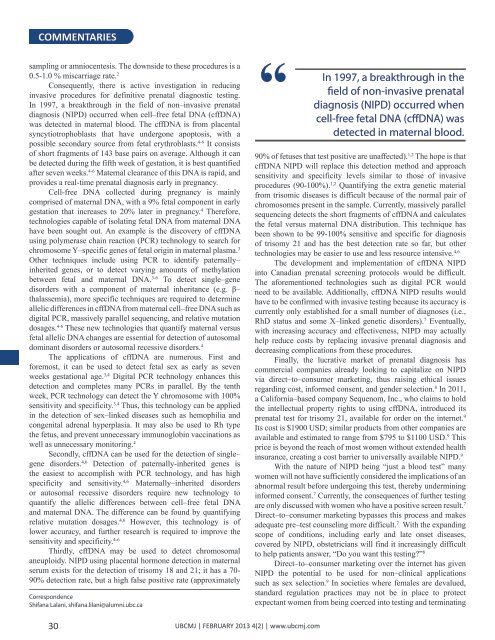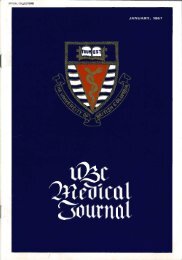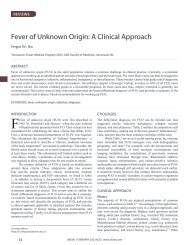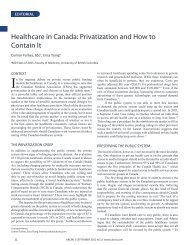Download full PDF - UBC Medical Journal
Download full PDF - UBC Medical Journal
Download full PDF - UBC Medical Journal
You also want an ePaper? Increase the reach of your titles
YUMPU automatically turns print PDFs into web optimized ePapers that Google loves.
COMMENTARIES<br />
sampling or amniocentesis. The downside to these procedures is a<br />
0.5-1.0 % miscarriage rate. 2<br />
Consequently, there is active investigation in reducing<br />
invasive procedures for definitive prenatal diagnostic testing.<br />
In 1997, a breakthrough in the field of non–invasive prenatal<br />
diagnosis (NIPD) occurred when cell–free fetal DNA (cffDNA)<br />
was detected in maternal blood. The cffDNA is from placental<br />
syncytiotrophoblasts that have undergone apoptosis, with a<br />
possible secondary source from fetal erythroblasts. 4-6 It consists<br />
of short fragments of 143 base pairs on average. Although it can<br />
be detected during the fifth week of gestation, it is best quantified<br />
after seven weeks. 4-6 Maternal clearance of this DNA is rapid, and<br />
provides a real-time prenatal diagnosis early in pregnancy.<br />
Cell-free DNA collected during pregnancy is mainly<br />
comprised of maternal DNA, with a 9% fetal component in early<br />
gestation that increases to 20% later in pregnancy. 4 Therefore,<br />
technologies capable of isolating fetal DNA from maternal DNA<br />
have been sought out. An example is the discovery of cffDNA<br />
using polymerase chain reaction (PCR) technology to search for<br />
chromosome Y–specific genes of fetal origin in maternal plasma. 3<br />
Other techniques include using PCR to identify paternally–<br />
inherited genes, or to detect varying amounts of methylation<br />
between fetal and maternal DNA. 3-6 To detect single–gene<br />
disorders with a component of maternal inheritance (e.g. β–<br />
thalassemia), more specific techniques are required to determine<br />
allelic differences in cffDNA from maternal cell–free DNA such as<br />
digital PCR, massively parallel sequencing, and relative mutation<br />
dosages. 4-6 These new technologies that quantify maternal versus<br />
fetal allelic DNA changes are essential for detection of autosomal<br />
dominant disorders or autosomal recessive disorders. 4<br />
The applications of cffDNA are numerous. First and<br />
foremost, it can be used to detect fetal sex as early as seven<br />
weeks gestational age. 3,4 Digital PCR technology enhances this<br />
detection and completes many PCRs in parallel. By the tenth<br />
week, PCR technology can detect the Y chromosome with 100%<br />
sensitivity and specificity. 3,4 Thus, this technology can be applied<br />
in the detection of sex–linked diseases such as hemophilia and<br />
congenital adrenal hyperplasia. It may also be used to Rh type<br />
the fetus, and prevent unnecessary immunoglobin vaccinations as<br />
well as unnecessary monitoring. 4<br />
Secondly, cffDNA can be used for the detection of single–<br />
gene disorders. 4,6 Detection of paternally-inherited genes is<br />
the easiest to accomplish with PCR technology, and has high<br />
specificity and sensitivity. 4,6 Maternally–inherited disorders<br />
or autosomal recessive disorders require new technology to<br />
quantify the allelic differences between cell–free fetal DNA<br />
and maternal DNA. The difference can be found by quantifying<br />
relative mutation dosages. 4,6 However, this technology is of<br />
lower accuracy, and further research is required to improve the<br />
sensitivity and specificity. 4-6<br />
Thirdly, cffDNA may be used to detect chromosomal<br />
aneuploidy. NIPD using placental hormone detection in maternal<br />
serum exists for the detection of trisomy 18 and 21; it has a 70-<br />
90% detection rate, but a high false positive rate (approximately<br />
Correspondence<br />
Shifana Lalani, shifana.lilani@alumni.ubc.ca<br />
“<br />
In 1997, a breakthrough in the<br />
field of non-invasive prenatal<br />
diagnosis (NIPD) occurred when<br />
cell-free fetal DNA (cffDNA) was<br />
detected in maternal blood.<br />
90% of fetuses that test positive are unaffected). 1,2 The hope is that<br />
cffDNA NIPD will replace this detection method and approach<br />
sensitivity and specificity levels similar to those of invasive<br />
procedures (90-100%). 1,2 Quantifying the extra genetic material<br />
from trisomic diseases is difficult because of the normal pair of<br />
chromosomes present in the sample. Currently, massively parallel<br />
sequencing detects the short fragments of cffDNA and calculates<br />
the fetal versus maternal DNA distribution. This technique has<br />
been shown to be 99-100% sensitive and specific for diagnosis<br />
of trisomy 21 and has the best detection rate so far, but other<br />
technologies may be easier to use and less resource intensive. 4,6<br />
The development and implementation of cffDNA NIPD<br />
into Canadian prenatal screening protocols would be difficult.<br />
The aforementioned technologies such as digital PCR would<br />
need to be available. Additionally, cffDNA NIPD results would<br />
have to be confirmed with invasive testing because its accuracy is<br />
currently only established for a small number of diagnoses (i.e.,<br />
RhD status and some X–linked genetic disorders). 7 Eventually,<br />
with increasing accuracy and effectiveness, NIPD may actually<br />
help reduce costs by replacing invasive prenatal diagnosis and<br />
decreasing complications from these procedures.<br />
Finally, the lucrative market of prenatal diagnosis has<br />
commercial companies already looking to capitalize on NIPD<br />
via direct–to–consumer marketing, thus raising ethical issues<br />
regarding cost, informed consent, and gender selection. 8 In 2011,<br />
a California–based company Sequenom, Inc., who claims to hold<br />
the intellectual property rights to using cffDNA, introduced its<br />
prenatal test for trisomy 21, available for order on the internet. 9<br />
Its cost is $1900 USD; similar products from other companies are<br />
available and estimated to range from $795 to $1100 USD. 9 This<br />
price is beyond the reach of most women without extended health<br />
insurance, creating a cost barrier to universally available NIPD. 9<br />
With the nature of NIPD being “just a blood test” many<br />
women will not have sufficiently considered the implications of an<br />
abnormal result before undergoing this test, thereby undermining<br />
informed consent. 7 Currently, the consequences of further testing<br />
are only discussed with women who have a positive screen result. 7<br />
Direct–to–consumer marketing bypasses this process and makes<br />
adequate pre–test counseling more difficult. 7 With the expanding<br />
scope of conditions, including early and late onset diseases,<br />
covered by NIPD, obstetricians will find it increasingly difficult<br />
to help patients answer, “Do you want this testing” 8<br />
Direct–to–consumer marketing over the internet has given<br />
NIPD the potential to be used for non–clinical applications<br />
such as sex selection. 9 In societies where females are devalued,<br />
standard regulation practices may not be in place to protect<br />
expectant women from being coerced into testing and terminating<br />
30<br />
<strong>UBC</strong>MJ | FEBRUARY 2013 4(2) | www.ubcmj.com










